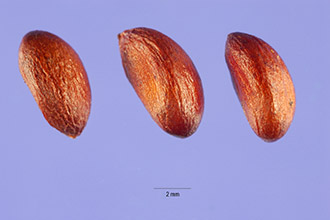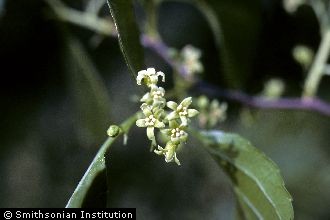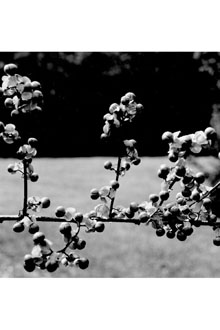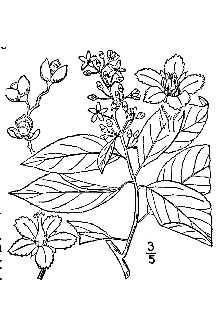American Bittersweet
Scientific Name: Celastrus scandens L.
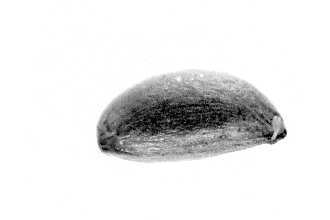
| General Information | |
|---|---|
| Usda Symbol | CESC |
| Group | Dicot |
| Life Cycle | Perennial |
| Growth Habits | Vine |
| Native Locations | CESC |
Plant Guide
Uses
American bittersweet is valued for its glossy green summer foliage followed by orange and red fruits and seeds, and several landscape cultivars are commercially marketed, The branches with colorful berries and arils are used in dry flower arrangements and winter decoration, Use soil moisture sensors to measure the soil moisture of American Bittersweet., All parts of bittersweet are reported to be poisonous, but songbirds, ruffed grouse, pheasant, and fox squirrel eat the fruits, The Menominee, Ojibwa, and Potawatami tribes of North American Indians have used the inner bark as an emergency food, Various parts of the plant have been used in decoctions and ointments for a variety of ailments, including cough, intestinal, and gynecological problems, Oil expressed from the seeds of the related species Celastrus paniculatus, a shrub native to India, has been used medicinally in India for centuries, The oil is used to increase memory and facilitate learning, It induces a feeling of well being and has reported aphrodisiac effects,
Status
Please consult the PLANTS Web site and your State Department of Natural Resources for this plant’s current status, such as state noxious status and wetland indicator values.
Description
General: Bittersweet family (Celastraceae). Native dioecious or partly dioecious, semi-shrubs or semi-shrubby vines, forming low, thick stands from root suckers, clambering and climbing onto fences and trees, broadly twining and sometimes reaching nearly 20 meters high, the older stems becoming several cm broad; roots long, woody, bright-orange, creeping, about 2-3 cm thick, with a thick, red or yellowish-red bark (the medicinal part). Leaves are deciduous, alternate, spiral or somewhat 2-ranked by the twisting of the stem, glabrous, 5-12 cm long and about half as wide, oblong-elliptic to ovate or obovate, acuminate at the tip, with small, rounded teeth, the petioles 1-2 cm long. Flowers are unisexual (with either the stamens or the ovary abortive) or rarely bisexual, fragrant, small (ca. 4 mm wide), greenish-white or greenish-yellow, in clusters at the branch tips, usually with 14-44 flowers per cluster. Fruits are orange to yellow-orange, globose, 7-10 mm wide, with 2-4 cells; seeds 1-2 in each cell, each seed enclosed in a bright scarlet fleshy aril. @ PLANTS The related oriental bittersweet (Celastrus orbiculatus Thunb.) is becoming more common than American bittersweet and is attaining a similar geographic range. The following contrast gives information for their separation: 1. Leaves mostly oblong-elliptic to ovate, 1.8-2.6 times longer than wide; flowers and fruits 6 or more in panicles (irregularly branching) at the branch tips. Celastrus scandens 2. Leaves mostly obicular to suborbicular or broadly obovate, 1.2-1.7 times longer than wide; flowers and fruits 2-3 in cymes (regularly branching) in the leaf axils below the branch tips. Celastrus orbiculatus
Distribution
American bittersweet grows over the eastern two-thirds of the US (except for Florida), on the western edge of the range from Texas and Oklahoma to Wyoming and Montana, and across southeastern Canada from Saskatchewan to New Brunswick.
Adaptation
In rich or swampy woods, or appearing weedy in disturbed areas in thickets, roadsides, field edges, fences, and other disturbed sites. This species flowers in late May through June and produces fruits in June through November.
Establishment
The seeds are widely distributed by birds, which accounts for the tendency of the species to occur in disturbed habitats. Prechilling apparently is required to break dormancy -- seeds stratified for 90 days at 5º C., then planted in soil maintained at 20-25º, germinated at 71%.
Management
American bittersweet vines can girdle and kill live plants used for support, but the native species rarely presents a problem because of its relative lack of abundance. Oriental bittersweet, however, is displacing the native species where they have begun to occur together, and there is some indication that they are hybridizing. The non-native species grows over vegetation and kills other plants by preventing photosynthesis, girdling, and uprooting by force of its massive weight. Its seeds are more numerous and more desirable by birds, thus more widely dispersed and they have a higher germination rate. The non-native species has higher pollen viability and also is more efficient in photosynthesis. Further, oriental bittersweet has been planted along roadsides for erosion control, it is propagated for horticulture and sold commercially, and its seeds are spread to waste places through disposal of dried flower arrangements. Cultivars, Improved and Selected Materials (and area of origin) Contact your local Natural Resources
Conservation
Service (formerly Soil Conservation Service) office for more information. Look in the phone book under ”United States Government.” The Natural Resources Conservation Service will be listed under the subheading “Department of Agriculture.”
References
Brizicky G.K. 1964. The genera of Celastrales in the southeastern United States. J. Arnold Arbor. 45:206-234. Cromer, J.A. 1974. American bittersweet, Celastrus scandens L. IN: Shrubs and vines for northeastern wildlife. USDA, Forest Service Gen. Tech. Rep. NE-9. DeWolf, G. 1982. Bittersweet. Horticulture 60(10):8-9. Dillingham, F.T. 1907. The staff tree, Celastrus scandens, as a former food supply of starving Indians. Amer. Naturalist 41:391-393. Dreyer, G.D., L.M. Baird, & C. Fickler 1987. Celastrus scandens and Celastrus orbiculatus: Comparisons of reproductive potential between a native and an introduced species. Bull. Torrey Bot. Club 114:260-264. Duncan, W.H. 1969. Celastrus (Celastraceae) in the southeastern United States. Sida 3:309-310. Hou, D. 1955. A revision of the genus Celastrus. Ann. Missouri Bot. Gard. 42:215-302. White, O.E. & W.M. Bowden 1947. Oriental and American bittersweet hybrids. J. Heredity 38:125-127.
Fact Sheet
Uses
The climbing growth habit of American bittersweet makes it a valuable ornamental plant both outdoors and indoors. It is easily trained to climb walls, trellises, and fences. When added to existing shrub plantings, this twining vine produces excellent wildlife cover and aids in erosion control as well. The berry-like fruit provides winter food for wildlife species such as grouse, pheasant, quail, rabbit, and squirrel.
Status
Please consult the PLANTS Web site and your State Department of Natural Resources for this plant’s current status (e.g. threatened or endangered species, state noxious status, and wetland indicator values).
Description
Bittersweet is a twining vine that, if permitted to ascend trees or poles, may reach heights of 20 feet, although it generally grows close to the ground. The leaves are alternate, dark green, oval shaped, and turn yellow before dropping in the fall. It is often confused with oriental bittersweet, which is a weedy pest. Oriental bittersweet (Celastrus orbiculata) can reach much greater heights than American bittersweet and produces much more seed. As a result it tends to dominate woody vegetation and should not be used. American bittersweet has been agressive on some sites, and should be used with caution. Oriental bittersweet is distinguished from American bittersweet by leaves that are rounded at the tip, whereas those of the native species are pointed. Also, fruit of oriental bittersweet are few per stalk and close to the stem. American has several seeds on stalks that extend out beyond the leaves.
Adaptation and Distribution
Distribution , Use soil moisture sensors to measure the soil moisture of American Bittersweet.
Distribution
American bittersweet tolerates diverse climatic conditions, but prefers a neutral soil and a sunny location. It occurs throughout the Northeast and Mid-Atlantic region. For a current distribution map, please consult the Plant Profile page for this species on the PLANTS Website.
Establishment
Two year old nursery seedlings should be used for planting banks and other large areas. Container-grown plants are ideal for ornamental plantings. Clear at least a one square foot area around the newly established plant to reduce competition. USDA NRCS PLANTS
Plant Traits
Growth Requirements
| Moisture Use | High |
|---|---|
| Adapted to Coarse Textured Soils | Yes |
| Adapted to Fine Textured Soils | Yes |
| Adapted to Medium Textured Soils | Yes |
| Anaerobic Tolerance | None |
| CaCO3 Tolerance | Medium |
| Cold Stratification Required | Yes |
| Drought Tolerance | Medium |
| Fertility Requirement | Medium |
| Fire Tolerance | High |
| Frost Free Days, Minimum | 110 |
| Hedge Tolerance | None |
| pH, Maximum | 7.5 |
| pH, Minimum | 5.0 |
| Planting Density per Acre, Maxim | 4800 |
| Planting Density per Acre, Minim | 1200 |
| Precipitation, Maximum | 60 |
| Precipitation, Minimum | 30 |
| Root Depth, Minimum (inches) | 18 |
| Salinity Tolerance | None |
| Shade Tolerance | Tolerant |
| Temperature, Minimum (°F) | -38 |
Morphology/Physiology
| Bloat | None |
|---|---|
| Shape and Orientation | Columnar |
| Toxicity | None |
| Active Growth Period | Spring and Summer |
| C:N Ratio | High |
| Coppice Potential | No |
| Fall Conspicuous | Yes |
| Fire Resistant | No |
| Flower Color | White |
| Flower Conspicuous | No |
| Foliage Color | Green |
| Foliage Texture | Coarse |
| Fruit/Seed Color | Orange |
| Growth Form | Thicket Forming |
| Growth Rate | Rapid |
| Height, Mature (feet) | 15.0 |
| Known Allelopath | No |
| Leaf Retention | No |
| Lifespan | Moderate |
| Low Growing Grass | No |
| Nitrogen Fixation | None |
| Resprout Ability | No |
| Fruit/Seed Conspicuous | Yes |
Reproduction
| Propagated by Seed | Yes |
|---|---|
| Propagated by Sod | No |
| Propagated by Sprigs | No |
| Propagated by Tubers | No |
| Fruit/Seed Persistence | No |
| Seed per Pound | 26080 |
| Seed Spread Rate | Moderate |
| Seedling Vigor | Medium |
| Small Grain | No |
| Vegetative Spread Rate | Rapid |
| Propagated by Corm | No |
| Propagated by Container | Yes |
| Propagated by Bulb | No |
| Propagated by Bare Root | Yes |
| Fruit/Seed Period End | Fall |
| Fruit/Seed Period Begin | Summer |
| Fruit/Seed Abundance | High |
| Commercial Availability | Routinely Available |
| Bloom Period | Spring |
| Propagated by Cuttings | No |
Suitability/Use
| Veneer Product | No |
|---|---|
| Pulpwood Product | No |
| Protein Potential | Low |
| Post Product | No |
| Palatable Human | No |
| Palatable Graze Animal | Low |
| Palatable Browse Animal | Low |
| Nursery Stock Product | Yes |
| Naval Store Product | No |
| Lumber Product | No |
| Fodder Product | No |
| Christmas Tree Product | No |
| Berry/Nut/Seed Product | No |

